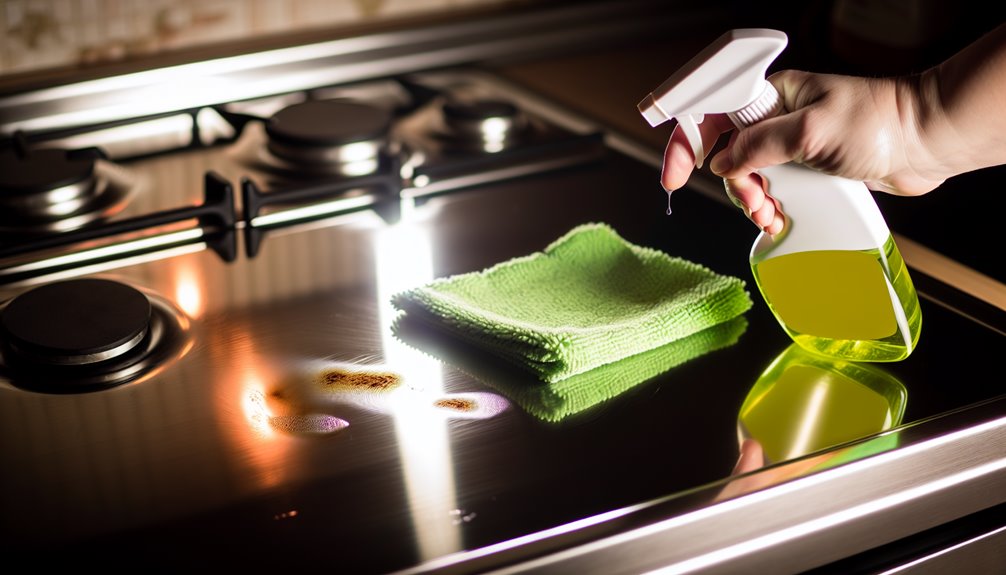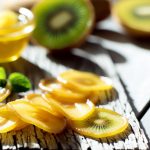To quickly clean kitchen grease off your stove, gather supplies like sponges, a microfiber cloth, and a degreaser or vinegar solution. Pre-treat stubborn stains with dish soap and warm water or a baking soda paste, letting it sit briefly. Then, scrub using a textured pad in circular motions, rinsing frequently. Finish by wiping down with warm, soapy water and drying with a microfiber cloth for a streak-free shine. There are more effective tips and tricks to discover!
Key Takeaways
- Gather cleaning supplies like sponges, microfiber cloths, degreaser, vinegar, and gloves for effective cleaning.
- Pre-treat stubborn grease stains with a dish soap solution or baking soda paste for better stain removal.
- Use a vinegar solution or lemon juice to naturally cut through grease while ensuring a fresh scent.
- Employ a scrubbing technique with safe pads, applying pressure in circular motions to dissolve grease effectively.
- Rinse with warm, soapy water, and dry with a microfiber cloth for a streak-free finish.
Gather Your Cleaning Supplies
Before you tackle that greasy stove, you’ll need to gather your cleaning supplies.
Start with basic cleaning tools like sponges, microfiber cloths, and a stiff-bristled brush. You’ll also want a reliable degreaser or a vinegar-water solution to combat different grease types. For tougher spots, a baking soda paste can work wonders.
Don’t forget gloves to protect your hands from harsh chemicals. If you have a scraper, it’s great for lifting stubborn residue without scratching surfaces. Having paper towels on hand makes for quick clean-up, too.
With these supplies ready, you’ll be well-equipped to tackle the grease and restore your stove’s shine. Let’s get started on that cleaning adventure!
Pre-Treat Stubborn Grease Stains
While tackling those stubborn grease stains, pre-treatment can make a world of difference. To enhance grease removal and help prevent future stains, follow these steps:
- Dish soap and water: Mix a few drops of dish soap with warm water to create a gentle cleaning solution.
- Baking soda paste: Combine baking soda with water to form a paste that can lift tough stains.
- Vinegar spray: Use a vinegar and water spray to help break down grease on contact.
- Commercial degreaser: Apply a store-bought degreaser for heavy-duty grease issues.
Apply your choice of pre-treatment directly to the grease stains, let it sit for a few minutes, and then wipe it away.
This simple step can lead to more effective cleaning and stain prevention.
Use Natural Cleaning Solutions
If you prefer a more eco-friendly approach, using natural cleaning solutions can effectively tackle kitchen grease. A simple vinegar solution is one of the best choices.
Mix equal parts of water and white vinegar in a spray bottle, then spray it directly onto greasy areas. Let it sit for a few minutes to break down the grease before wiping it away with a soft cloth.
Another great option is lemon juice. The acidity helps cut through tough grease while leaving a fresh scent. You can either use it straight or mix it with the vinegar solution for added power.
These natural options aren’t only safe for your kitchen but also gentle on the environment, making your cleaning routine both effective and responsible.
Employ a Scrubbing Technique
To effectively remove stubborn grease from your stove, employing a scrubbing technique can make a significant difference. Here are some effective techniques to try:
- Choose the Right Scrubbing Pads: Opt for pads that are tough on grease but safe for your stove surface.
- Apply Pressure: Firmly press the scrubbing pad against the grease, using a circular motion for better results.
- Use Hot Water: Dampen the scrubbing pad with hot water to help dissolve the grease more easily.
- Rinse Frequently: Rinse the pad often to prevent grease buildup and guarantee you’re effectively removing grime.
Rinse and Wipe Down
Once you’ve scrubbed away the grease, it’s time to rinse and wipe down the surface.
Use warm, soapy water to ascertain any leftover residue is lifted away.
Finally, dry the area with a microfiber cloth for a streak-free finish.
Use Warm Soapy Water
Using warm soapy water is one of the most effective ways to tackle kitchen grease on your stove. This method not only helps with grease removal but also guarantees your surface stays safe from harsh chemicals.
Here’s how to do it:
- Fill a bowl with warm water and add a few drops of dish soap.
- Dip a sponge or cloth into the soapy water, making sure it’s damp but not soaking wet.
- Gently scrub the greasy areas on your stove, focusing on tough spots.
- Rinse the sponge or cloth in clean warm water, then wipe down the stove to remove any soap residue.
Dry With Microfiber Cloth
After you’ve scrubbed the grease away, drying your stove properly is essential to prevent streaks and water spots.
Using a microfiber cloth is your best bet for this task. Microfiber benefits include its ability to absorb moisture and trap dirt effectively, making it ideal for this job.
When choosing cloth types, opt for one that’s soft and non-abrasive to avoid scratching your stove’s surface. Simply wipe down the area, ensuring you cover all spots where moisture remains.
If you notice any stubborn areas, a quick second pass with a clean microfiber cloth can help.
In no time, your stove will shine, free from grease and water spots, ready for your next cooking adventure!
Prevent Future Grease Buildup
To keep grease from accumulating on your stove, it’s essential to adopt some proactive habits during cooking.
Implementing effective grease prevention strategies can save you time and effort later. Here are some kitchen habits to take into account:
- Use a splatter screen: This helps contain grease while you fry or sauté.
- Cover pots and pans: When simmering or boiling, lids can minimize splatter.
- Wipe spills immediately: Don’t wait for them to cool; a quick clean-up prevents buildup.
- Maintain good ventilation: Turn on your range hood or open windows to reduce airborne grease.
Frequently Asked Questions
Can I Use Vinegar on Stainless Steel Surfaces?
Absolutely, you can use vinegar on stainless steel! Its benefits include cutting through grime while promoting shine. Just remember, gentle care guarantees your surfaces stay gleaming and resistant to stains, keeping your kitchen looking fabulous.
What if My Stove Has a Non-Stick Coating?
If your stove has a non-stick coating, prioritize gentle cleaning methods. Use a soft cloth or sponge, avoiding abrasive materials, to maintain the coating’s integrity while effectively removing grease without damaging your cookware’s surface.
Are Commercial Cleaners Safe for Food Surfaces?
When considering commercial cleaners for food surfaces, you should check the chemical ingredients. Many contain harsh substances, so explore safer cleaning alternatives like vinegar or baking soda to guarantee your kitchen stays both clean and safe.
How Often Should I Clean My Stove?
You should clean your stove regularly—ideally after every use. This not only maintains its shine but also prevents buildup. Consistent cleaning frequency is key; follow these maintenance tips to keep your kitchen sparkling and safe.
What Tools Should I Avoid When Scrubbing?
When scrubbing your stove, avoid using steel wool and abrasive sponges. They can scratch surfaces and damage finishes. Instead, opt for gentler tools that clean effectively without harming your stove’s appearance.



